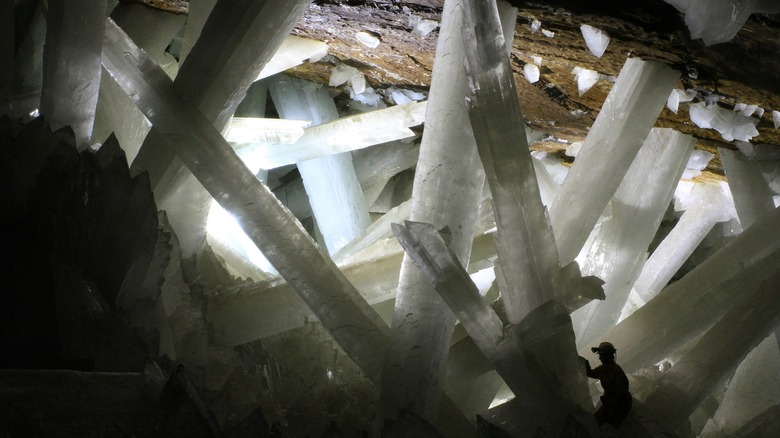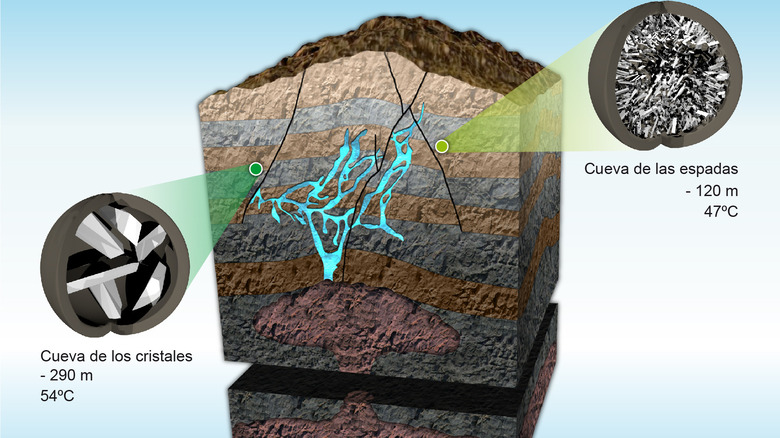This Crystal Cave Is One Of The Most Dangerous Places In The World
At first, the "Cueva de los Cristales" — or "Cave of the Crystals" — sounds like a beautiful place to visit. The name alone is enticing, combining the mysterious allure of caves with the stunning beauty of crystals. But, as it turns out, caves and crystals can be a deadly combo.
As National Geographic reports, the Cave of the Crystals is located underneath Naica, a small town in the Mexican state of Chihuahua. Naica is a mining town; per How Stuff Works, lead, zinc, and silver have been extracted from the Naica mine since the mid-1800s. But, in 1910, miners found something else: a cavern full of crystals of calcium sulfate dihydrate, better known as selenite. These crystals were fairly large, reaching up to 8 feet in length. But then, in 2000, further mining operations revealed an even more impressive find: a separate cave of massive selenite crystals. By massive, we mean massive; for scale, notice the person in the photo above. According to one survey, the cave's largest crystal is 37 feet long, with an estimated weight of 13 tons.
This crystal cave is nearly 1,000 feet below the surface. As How Stuff Works explains, the crystals formed when mineral-rich water was pushed towards Earth's surface by a magma chamber below. The magma initially kept the water-filled cavern at a high temperature, but it eventually cooled down, allowing the water's minerals to accumulate into selenite crystals. This accumulation took an incredibly long time; per the website Phys, one study estimated that the massive crystals formed over a period of 500,000 to 1 million years.
Extreme heat and humidity make Mexico's Cave of the Crystals fatal to humans
So far, the Cave of the Crystals probably sounds pretty cool, right? Like somewhere you'd want to check out during your next visit to Mexico? Well, now we should mention the dangerous part.
To begin with, the Cave of the Crystals is incredibly hot. Per How Stuff Works, the air temperature inside the cave ranges from 113degrees to 136 degrees Fahrenheit. Similarly, the cave is one of the most humid environments imaginable; the cavern's air frequently reaches 99% humidity. This heat-and-humidity combo can be, unsurprisingly, quite deadly. Without the proper protection, exposure to the cave's air can lead fluid to accumulate in a visitor's lungs, leading to death.
Scientists who have studied the cave have had to take immense precautions to protect themselves, wearing special refrigerated suits along with breathing equipment. Even with all this, researchers rarely entered the cave for more than a half-hour at a time. But hazardous conditions haven't stopped everyone from entering. According to Earth Magazine, one Naica miner managed to sneak into the cave in an attempt to steal selenite crystals, but he lost consciousness and was found dead.
Even so, there are probably some daredevils out there who'd love a chance to enter the cave, dangers be damned. Thankfully, entering the cave has become impossible. Per How Stuff Works, while the cave was unflooded by mining activity back in 2000, the cave was allowed to reflood in 2017, thus preserving the crystals.

